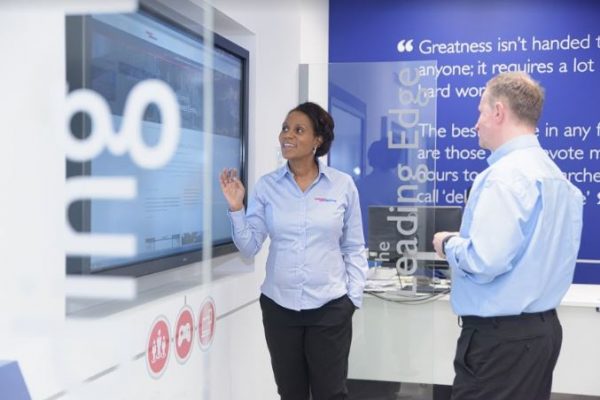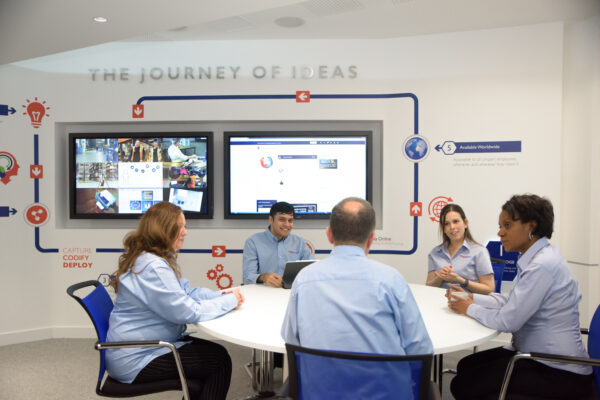 The challenge
The challenge
Unipart’s Consultancy were challenged to transform the department’s efficiency through embedding a sustained culture of continuous improvement over a five-year period, with the specific request of generating a 30% productivity uplift and improvements in quality.
The transformation programme called PaceSetter, focused on improving leadership capability and employee engagement alongside significantly improving processes and addressing enterprise-wide value creation across the department.
How we helped – initial phase
The original scope of our work was to rollout four ‘standard process solutions’ to ten Large Processing Offices, train up to 150 HMRC people to become ‘Central Experts’ in continuous improvement techniques and to design six standard solutions for the National Insurance Contributions Office (NICO). This first phase delivered to plan and budget, and achieved substantial performance improvements, typically:
- Productivity uplifts in the processing of self assessment tax returns (both paper and electronic submissions) and associated documents ranging from 30% – 80%
- Quality (accuracy) improved by 50% minimum
- Backlogs of work eliminated
The early successes of PaceSetter resulted in the programme expanding into the Tax Credit Office, the Child Benefit Office, VAT National Operations and fifteen smaller processing offices. At the peak of the work, Unipart Consultancy had more than 50 Consultants working across the UK. Over 50 processes were re-designed, with new team structures implemented.
Our Consultants engaged employees at every level and built their capability to ensure the new ways of working embedded and sustained. Teams were shown how to map their processes, identify and eliminate waste and develop improved ways of working themselves. Training in problem solving techniques equipped them to deal with day-to-day issues rather than delegate them up the line. Visual management tools and sustainment techniques were employed to ensure long-term continuous improvement.
A model office was setup to give HMRC people the opportunity to go and see all of the PaceSetter tools and techniques working together, to meet and talk to colleagues who use them in their daily
work and to see a new style of leadership behaviour in operation. As a result of the sustainment measures put in place, through the engagement of employees, the development of capability and infrastructure, NICO has achieved a further 20% improvement in productivity since the original project ended.
 How we helped – second phase
How we helped – second phase
The performance results achieved exceeded HMRC’s best expectations, but this only affected one directorate within one line of business (personal tax). At that time HMRC employed over 94,000 people. We began working with programme leaders to develop the architecture for long-term sustainment of PaceSetter.
This consisted of:
- A set of principles agreed with the Executive Committee (ExCom) that would guide management’s approach.
- A set of leadership behaviours for all managers to practice
- A roadmap for the Lean journey to be undertaken by each directorate
- A defined set of tools and techniques for the organisation
- A career structure for the practitioners being trained in the Lean Academy
- A set of assurance and sustainment processes. When we commenced the second phase deployment, in the debt pursuit function, taking over from a previous programme that had failed to achieve performance improvement. Within 12 months, productivity uplifts of 35% were being achieved.
By the end of our five-year deployment, we successfully delivered and embedded PaceSetter way of working in:
- Enforcement and compliance case handling offices
- HR service centres
- Customer contact (call) centres
- IT software design
- Tax credit policy re-work
- Various transactional processes.
Leadership development
To ensure the long-term sustainability of PaceSetter, our team engaged, coached and trained the senior executives of HMRC (Director Generals and Directors), developing their capability in applying the PaceSetter ways of working. We coached them in understanding how to manage the organisation in a different way in order to sustain a culture of continuous improvement.
Executives went on a series of visits to Unipart and HMRC to see PaceSetter and The Unipart Way in action and talk to people using the tools on a day-to-day basis. We delivered training interventions to introduce executives to the continuous improvement principles and terminology that was widely employed in their departments. We provided one-to-one assessment, feedback and coaching in leadership behaviours.
Through policy deployment workshops, various strategies and initiatives with PaceSetter and the wider organisation’s objectives were aligned. Visual management boards were created to enable Directors to see at a glance how their departments were performing.
Benefits
PaceSetter was established as the single means of transforming HMRC’s culture into one in which continuous improvement is driven by the people who do the work:
- PaceSetter has generated the equivalent of £400 million of savings and £860 million of tax yield, as acknowledged by the Department
- On average, PaceSetter has created productivity increases of at least 30% and improvements and value for money for the taxpayer, it has led to increased debt recovery in mainstream taxes work and error and fraud returns in HMRC’s Benefits and Credits business
- Headroom was created to take in new work, reduced lead times for customers and vastly improved ‘right first time’ quality (from 49 to 99% in some cases) from the strategic objectives and supporting improved decision making and performance from the Executive Committee to the frontline
- Creation of performance hubs and boards, at all levels of management, are providing a visual line of sight
- Upwards of 1,000 senior leaders and managers have undergone PaceSetter coaching or formal training
- Over 450 internal PaceSetter practitioners have the capability to continue to improve HMRC’s performance with the skills and competencies we have provided
- Greater expansion and adaptation of the PaceSetter into business areas whose work is less transactional and more considerative, such as policy units, has been achieved with an early success showing improvements in cycle time within one specialist area reducing from 7 years to 11 months
- The PaceSetter brand and the disciplines around maintaining its integrity is now well established and recognised both within Whitehall and beyond.